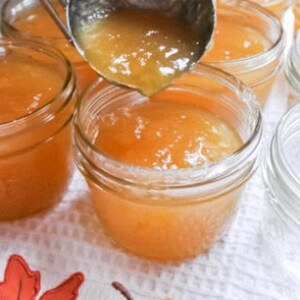
- 6 pounds fresh ripe Bartlett USA Pears, about 12 large
- 1 fresh ripe pineapple
- 2 fresh lemons, juiced (or ¼ cup bottled lemon juice)
- 8 cups sugar
Note: Prepare canning jars and keep hot until ready to use; prepare lids according to the manufacturer’s instructions. (If macerating the fruit and sugar mixture overnight, you will want to wait until the next day to prepare the jars.)
Peel, core, and cut pineapple into chunks, trying to retain as much juice as possible. Place chunks and any juice into a large bowl. (I cut chunks on a cutting board with an outer groove that collects the juice.)
Cut the lemons in half and squeeze their juice over pineapple in bowl. (Or add bottled lemon juice.)
Peel, core, and cut pears into chunks and add them to the pineapple and lemon juice. You should have approximately 12 cups of fruit.
Add sugar to the fruit mixture, stir well to combine and cover. Let it sit on the counter at least one hour, but preferably 8 hours, or even overnight. The longer it sits, the more juices will be pulled from the fruit, forming a wonderful syrup in the bowl.
After letting the mixture sit the desired time, stir mixture together well, scraping any sugar that might have collected on the bottom of the bowl.
Place mixture in a heavy-bottomed non-reactive pan. Bring to a boil over medium high heat and cook for about 20 minutes, stirring occasionally to prevent the fruit from sticking to the bottom of the pan. Stir the fruit gently while cooking to reduce foaming.
After about 20 minutes, the fruit should be softening, and you can use an immersion blender or potato masher to periodically mash the chunks and create a smooth texture.
Boil for 5-15 more minutes, stirring, until the jam either thickens to your liking or until it reaches 220 degrees on a candy thermometer. You can also use the sheeting test.
Ladle jam into clean hot jars to within ¼” of the top, wipe rims spotlessly clean and place a lid on top of jar. Next, screw a band onto the jar until finger-tight.
Process for 10 minutes* in a boiling water bath.
Turn kettle off and let jars rest in kettle for 5 more minutes.
Remove jars from kettle using jar-lifter tongs, and gently set aside to cool on the counter, on a kitchen towel, in a draft-free place.
Let rest for 24 hours, then check jars for a proper seal before storing.
If jar lid seals, it will keep for one year in a cool, dark place. If jar doesn’t seal, place in your refrigerator and eat within 3 months, and within one month after opening.
Important: Check lids for a proper seal by pressing down on the middle of the lid with a finger or thumb. If the lid stays down, it is sealed and will easily keep for up to one year in a cool dark place. If the lid springs up when you release your finger, the lid is not properly sealed.
*0-1000 ft: process 10 minutes
1,001-6,000 ft: process 15 minutes
Above 6,000 ft: process 20 minutes
yield: Makes about 12 half pints
- Serving Size: 1 TBSP
- Calories: 40
- Carbohydrates: 11g
- Protein: 0g
made this but changed a few things because I did not have available. I had to use a cup of strawberry & kiwi drink I had on hand and added a little lemon juice. Then I had some red hot candies and thought they would add a special kick to it. I reduced 1 cup of sugar. & It came out fantastic.
it should!
Learning bunches from all the comments… Does this recipe thicken as it sets?
We have not personally tried this, but to substitute honey for white sugar in baked goods, use 3/4 cup honey for every 1 cup of sugar. Honey adds a lot of moisture to a recipe, so reduce other liquids in the recipe by ½ cup for every 1 cup of honey added. Hope that helps!
I haven’t made this yet but wondering how much honey would one use instead of sugar. I prefer to use honey as we have hives in our orchard.
Good
The same as my great grandmother’s recipe. Except its easier if you grind the peeled and cored pears first. Crushed pineapple fixes the string issue or a can of apricots can be used instead ( prefer the apricots). The last thing is I learned the hard way pears turn pink if the air hits them to long. But it still tastes amazing!
We think that would work!
Thank you! My pear honey turned out beautifully! I added 2 tsp. of cinnamon and it was perfect! Question: I used a fresh pineapple, but I had an issue getting the strings mashed. I ended up putting all of my cooked ingredients into my kitchenaid mixer. The whisk collected/seperated all of the strings so I poured the honey back into my pot and whisked the heck out of the pineapple strings. It worked perfectly, however, it was just an additional process I would rather not do. Can you use canned crushed pineapple instead of fresh? Thanks again!!!!
There is 2 reasons why it was called “Pear Honey”.
1. Originally honey is what was used to sweeten with, before processed sugar came about.
2. As a previous comment stated, once processed it turns darker.
It got the name ‘honey’ due to the color that it turns as it gets done. The golden brown color.
Interested in Pears, from when they ripen to canning & Peserves.